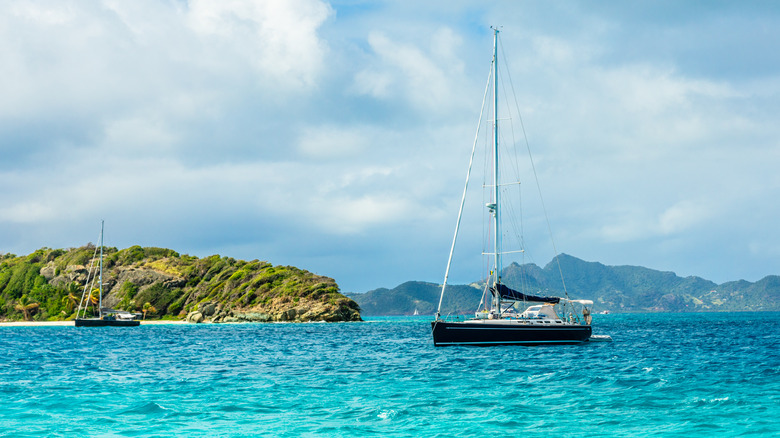Situated Between Saint Vincent And Grenada Is An Underrated Snorkeling Destination With Turquoise Bays
Those Caribbean blues — turquoise, crystal-clear, royal, and jade-green — define a picture-perfect sea that contrasts with sparkling soft sands to create the most inviting environment. Beneath the surface of this gorgeous expanse lives a vast underwater world of coral reefs, seagrasses, sea creatures, and shipwrecks, attracting snorkelers, divers, and beach-combers alike. While the Bahamas gets plenty of attention as the most accessible Caribbean destination for U.S. travelers, one of the region's most underrated gems lies farther south: A 600-island chain sprawling roughly 60 miles across the West Indies in the Lesser Antilles, between St. Vincent in the north and Grenada to the south. These are the Grenadines — a sailor's paradise known for steady trade winds, protected marine parks, stunning beaches, tropical climate, and plentiful anchorages.
This spackling of islands is divided between two nations. St. Vincent and the Grenadines includes 32 islands, such as Bequia, celebrated for its natural beauty and position outside the hurricane belt, as well as Mustique, Canouan, and Mayreau, gateway to the Tobago Cays Marine Park, renowned for world-class diving and pristine coral reefs. Toward the archipelago's south end, Grenada — one of the best places in the Caribbean to retire thanks to its idyllic beaches and welcoming citizenship process — includes Carriacou and Petite Martinique, each with its own relaxed, authentic island charm and, of course, great snorkeling.
Not all of the Grenadines islets and cays are inhabited. Some are so small, they are visited only by sailors seeking anchorage or snorkelers in search of a few hours on a private beach. Whether you're sailing your catamaran around the world, chartering a yacht "Below Deck"-style, or simply hiring a local dive boat for the day, the Grenadines offer unmatched tropical adventure and some of the best snorkeling in the entire Caribbean.
The northern Grenadines has a bucket list of incredible snorkeling sites
As toxic sargassum increasingly pollutes Bahamas beaches, there's even more reason to head south to the Grenadines. On the north end, St. Vincent is fairly accessible from the U.S. and boasts prime snorkeling in Wallilabou Bay, where coral gardens and a "pirate's arch" flourish along steep reef walls. Bequia, 11 miles south, has numerous sheltered bays pocketing its coastline and colorful reefs rimmed by peaceful beaches, perfect for both beach snorkeling and boat tours. Princess Margaret Bay and Lower Bay on Bequia are protected reefs hosting turtles, rays, and lobsters. For the adventurous, nearby Petite Byahuat in Buccament Bay is a remote nature preserve with an underwater cave accessible only by boat; at low tide, adventurers can swim through a narrow tunnel into a subterranean chamber filled with bats.
From St. Vincent, hop a puddle jumper to Canouan for delightful beach snorkeling, and then take a ferry to Mayreau, a small island with incredible snorkeling offshore. Mayreau Gardens is a vibrant reef system, with exotic fish, sharks, green and hawksbill turtles, and pristine coral. At its edge sits Horseshoe Reef. Water here has 60 feet of visibility and rich biodiversity, and forms a shield for snorkelers in the protected Tobago Cays Marine Park, which spans five tiny islands and 1,400 acres of pristine reefs and crystal waters reachable only by boat. Arguably the crown jewel of Caribbean snorkeling and diving, it also offers diving at the Puruni Wreck, a 1918 British battleship sunken nearby.
Look for migrating birds at the Catholic Rock-Bird Sanctuary near Mustique, a privately-owned island popular with celebrities, with excellent beaches and noteworthy snorkeling coves, like Gallicaux Bay — a hidden gem — and Lagoon Bay, "The beach to end all beaches," as one Tripadvisor reviewer described.
The Southern Grenadines includes an underwater sculpture gallery
Head south to Carriacou, a snorkeler's paradise known as the "Isle of Reefs." The island's underwater forests and coral gardens are packed with marine life, from brain coral and stingrays to schools of tropical fish. Paradise Beach is one of the island's best spots, with calm, shallow waters perfect for all levels of swimmers and snorkelers. Just a short water-taxi ride away, Sandy Island has a protected coral reef within the Sandy Island Oyster Bay Marine Protected area. The water teems with tropical fish and vibrant coral, and the white sand beach feels wonderfully remote. You can reach Carriacou via a 20-minute flight from Grenada, or a two-hour ferry. Just northeast, tiny Petite Martinique has tranquil snorkel beaches, too.
At the southernmost end of the Grenadines, Grenada is a must for snorkelers, home to the unique Molinere Underwater Sculpture Park in Molinere Bay. This 75-sculpture, underwater gallery enhances the reef and fosters natural coral growth. Depths range from 16 to 30 feet, making it accessible to snorkelers. A popular way to visit is by glass-bottom boat tour, just a 10-minute ride from St. George's, Grenada's capital. "Absolutely fabulous experience!" raved one Tripadvisor reviewer. "Do not miss this excursion! It is a very emotionally moving encounter witnessing this meaningful exhibit." Though not technically part of the Grenadines, Grenada offers plenty of other excellent snorkeling spots, including BBC Beach, Magazine Beach, and Aquarium Beach.
Getting to the Grenadines from the U.S. can be a little more challenging than flying to, say, Bimini, but the journey's worth it for that perfect, laid-back Caribbean vibe and some of the best snorkeling in the world. The dry season — January to April — is the ideal time to visit, with average temperatures around 80 degrees Fahrenheit.


